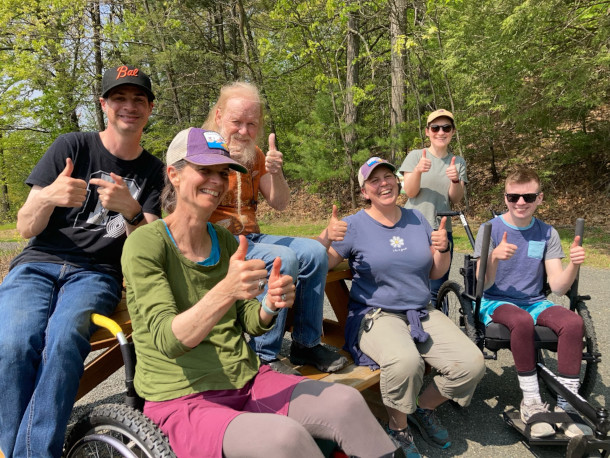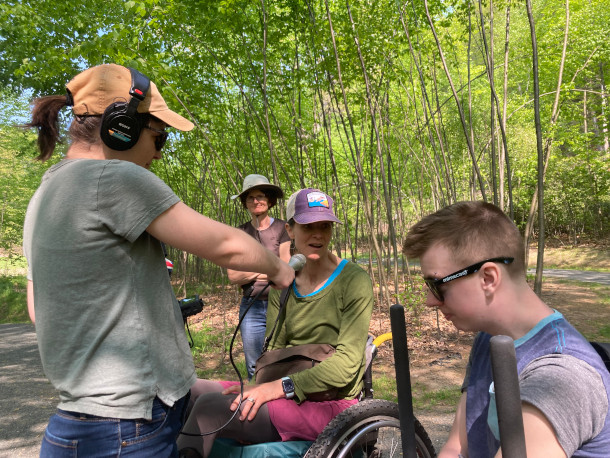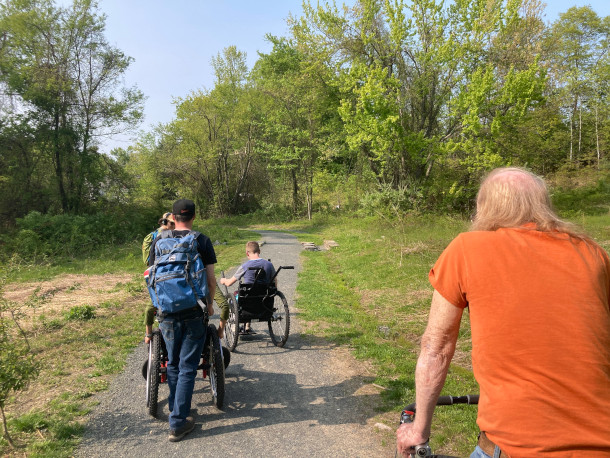Hiking on Wheels
Air Date: Week of October 11, 2024

Pictured left to right: Fionn Murphy (All Out Adventures program assistant), Amy Sugihara (All Out Adventures participant), Tom Skinner (All Out Adventures participant), Karen Foster (All Out Adventures executive director), Jenni Doering, and El Wilson. (Photo: Sue Tracy, All Out Adventures)
Physical disabilities can make getting outside more challenging, but adaptive devices and accessible trails can transform lives. Producer El Wilson, who has cerebral palsy, and producer Jenni Doering test an offroad wheelchair and meet a woman who has been able to reclaim the joy and freedom of hiking since becoming disabled.
Transcript
WILSON: It’s Living on Earth. I’m El Wilson.
DOERING: And I’m Jenni Doering. El is a producer here at Living on Earth who uses they/them pronouns. But you rarely hear their voice on the show. That’s because El has cerebral palsy, or CP.
WILSON: Cerebral palsy is a disorder you’re born with that changes the way your brain controls your body.
DOERING: In addition to how CP affects El’s voice, they have a hard time balancing. So, El uses a manual wheelchair to get around.
[SFX OF EL’S EVERYDAY WHEELCHAIR]
DOERING: It’s not like a standard-issue wheelchair you’d see in a hospital or an airport. It was custom built to fit and be powered by El, who’s pretty small and lean. This wheelchair can cruise down the Boston hills, give rides to El’s fluffy orange cat, Cleo, and pop wheelies on the dance floor - to Taylor Swift, of course.
[SFX OF EL’S EVERYDAY WHEELCHAIR]
DOERING: But one thing it just can’t do is go offroad.
[SFX OF GRIT WHEELCHAIR]
DOERING: So, on this warm sunny day, El and I have come out to Mount Tom North Trailhead Park in western Massachusetts to learn how people with mobility challenges can explore the outdoors. El is going to take an offroad wheelchair for a spin, so they push out of their usual chair and with a bit of help ease into a more rugged rig called a Grit Freedom Chair.
[SFX - EL GETTING INTO CHAIR]
WILSON: Thank you.
FOSTER: You’re welcome.
DOERING: Now today we’re not just tooling around on a flat patch of dirt. We’re on a new accessible trail that heads up a hill, so El is in for a workout! But I’m confident El can do it, and the Grit chair looks up to the challenge. The tires are wider than the ones on El’s usual chair and the front wheels stick out far in front, so it doesn’t tip forward. And instead of simply rolling the wheels, El is going to push and pull two levers that allow a seated hiker to winch up a hill like this one.

Amy got involved in All Out Adventures after a degenerative disease made typical hiking impossible. (Photo: Karen Foster, All Out Adventures)
[SFX GRIT CHAIR]
FOSTER: We might need the lesson on how to use it, actually, from Amy over there…
WILSON: Yeah.
FOSTER: because this is her chair.
DOERING: Karen Foster, Executive Director of All Out Adventures, points us toward a woman with a slight frame like El’s with brown hair and an outdoorsy vibe.
FOSTER: Hi, I’m Amy Sugihara, participant with All Out Adventures.
DOERING: Amy is maybe twice El’s age at around 50 and about 8 years ago she was diagnosed with a degenerative disease. So now she uses a manual wheelchair to get around town and the Grit chair for hiking. Like a lot of adaptive sports equipment, Grit Freedom chairs come with a hefty price tag. They cost three to six thousand or so, more than your average manual chair. The VA will cover the cost of a chair for eligible veterans. And others can apply for funding through state grants and nonprofits.
[SFX GRIT CHAIR]
DOERING: The makers of the Grit chair claim it’s twice as efficient as an everyday
wheelchair because of how it uses those levers, attached to gears that turn the wheels. It’s kind of like the difference between climbing a hill on a bike with gears versus a fixie. In fact, the Grit Chair uses bike parts so it’s much easier to repair than a typical wheelchair. But just like riding a bike… it takes practice.
DOERING: Okay, how does it feel so far?
WILSON: Hard ‘cause it’s like a muscle group I don’t use, ever.
DOERING: What you need to know is that El is an athlete who plays sled hockey, a full contact sport played on the ice that can get just as intense as the sport the Bruins play.
[SFX - EL GOING UP THE HILL]
DOERING: But this is still hard work. The crushed stone trail starts out in a meadow and soon climbs into the dappled light of the forest, giving us welcome shade. To make the trail accessible, the path is relatively even, it never gets too steep, and it has flat rest areas that follow each incline. Without accessible trails like this one, hiking would remain inaccessible for many with disabilities.
[SFX - EL GOING UP THE HILL]
DOERING: Now, you might be wondering as I did – why isn’t it paved, if it’s meant to be an accessible trail? Karen Foster says what she’s learned in her work helping people of all abilities experience the outdoors is that unpaved trails can be better than pavement in a lot of ways.
FOSTER: It’s so different being in the woods on an unpaved trail – you know, all the sensory benefits, it’s cooler, we’re in the shade.
DOERING: You feel more connected to the outdoors when you’re on a trail with a more natural surface like crushed stone.
[SFX - EL GOING UP THE HILL]
DOERING: But you also feel the burn, and in the Grit Chair, El is struggling and gratefully accepts Karen’s offer to help push. As we all take a much-needed rest on the way up the mountain, Amy Sugihara tells us she used to take on much more difficult trails than this one.
SUGIHARA: My mobility has been declining gradually over the last ten years. So, I used to be a big hiker, when I was able-bodied. And then as my mobility declined, my world just kind of closed in, you know. And I didn’t think I could hike anymore. I mean it just; it didn’t occur to me that there were ways to get out.
DOERING: Now, this might be El’s first-time hiking since their dad could give piggy back rides, but “getting out” has never been a problem. El has always had CP, and they were always told, you can do anything with the right attitude and equipment.
WILSON: Oh yeah, water skiing, rock climbing, zip lining, wheelchair lacrosse, wheelchair basketball, and sled hockey, of course.

Unpaved accessible trails allow people with disabilities to access more natural landscapes than paved trails do. (Photo: Karen Foster, All Out Adventures)
DOERING: Nothing felt out of reach for El. But Amy had to adjust to a new life without the abilities she’d always taken for granted. So, at first, she felt really stuck.
SUGIHARA: I searched online looking for… Outdoor… I don’t remember what I put in exactly, probably “outdoor adventure,” and All Out Adventures popped up. ‘Cause I wanted to do something with my son who was then going into eighth grade. And it was like, “No way! Oh, my goodness!” And I called because I saw their recumbent trike program in the summer. And I thought, “Oh, my son and I could do this together.”
[SFX PHONE RINGING]
DOERING: And Karen answered the phone.
[SFX PHONE RINGING]
FOSTER: When I get to be the person on the phone that says, “Yes,” or grab the right piece of Velcro or the right bike pedals or know the piece of equipment that’s gonna work for somebody… And then I see spouses off on a bike ride together or siblings, you know, ice skating and playing chase. And when I get to see those connections in action, it’s kinda everything.
DOERING: And for Amy, being able to experience the outdoors with her family again changed her life.
SUGIHARA: It just completely opened up my world. I think we all gain a lot from being outside in nature.
DOERING: Like Amy I love to hike, and before today it had never quite sunk in for me that we don’t all have equal access to the outdoors. El says that can be a tendency for a lot of us able-bodied folks!
WILSON: All of you take everything for granted all the time!
[SFX – EL GOING UP THE HILL]
DOERING: At last, by wheel and on foot, we make our way to the top, to a clearing overlooking the Connecticut River Valley.
FOSTER: This is the view we’ve been hiking for!
DOERING: It’s so green.
WILSON: Wow.
DOERING: What do you think, El?
WILSON: Beautiful. Thank you.
DOERING: As we take in the view, we have a moment to chat with Karen about who All Out Adventures serves.
FOSTER: One of the things that people don’t necessarily understand about our programs is that only about half of our participants have disabilities. And the other half are their loved ones.
DOERING: And it turns out, there are a lot more people who can benefit from accessible trails like this one than you might think. Pregnant people, anyone pushing a stroller, elders, and more. But Karen says these trails won’t get built without able-bodied folks stepping up as allies to people with disabilities.
FOSTER: People who don’t have disabilities are more visible trail users. So, the more they advocate for the full inclusion of everybody in trail design and trail use, that’s really significant.
DOERING: Life has gotten better for people who use wheelchairs since the Americans with Disabilities Act became law in 1990. But there’s still a long and bumpy road ahead to breaking down barriers. And for El and me it’s a long road back home to Boston so we need to get going. And El’s cruise back down the trail offers a chance to test out just how fast the Grit Chair can go.
[SFX: EL GOES ZOOM]
DOERING: Having to run to keep up! But you just go! There they go, off down the hill.
[SFX OF JENNI RUNNING TO KEEP UP WITH EL]
[SFX OF GRIT CHAIR GOING DOWNHILL]
DOERING: Wow! Did you get some adrenaline?
WILSON: [LAUGHS] Uh hah, that was really fun!
SUGIHARA: You know, the more we with disabilities go out into the world and live our lives, the better it is for everybody. I think we’re all better off.
Links
Learn more about the accessible trail at Mount Tom North Trailhead Park
Visit All Out Adventures’ website
Living on Earth wants to hear from you!
Living on Earth
62 Calef Highway, Suite 212
Lee, NH 03861
Telephone: 617-287-4121
E-mail: comments@loe.org
Newsletter [Click here]
Donate to Living on Earth!
Living on Earth is an independent media program and relies entirely on contributions from listeners and institutions supporting public service. Please donate now to preserve an independent environmental voice.
NewsletterLiving on Earth offers a weekly delivery of the show's rundown to your mailbox. Sign up for our newsletter today!
 Sailors For The Sea: Be the change you want to sea.
Sailors For The Sea: Be the change you want to sea.
 The Grantham Foundation for the Protection of the Environment: Committed to protecting and improving the health of the global environment.
The Grantham Foundation for the Protection of the Environment: Committed to protecting and improving the health of the global environment.
 Contribute to Living on Earth and receive, as our gift to you, an archival print of one of Mark Seth Lender's extraordinary wildlife photographs. Follow the link to see Mark's current collection of photographs.
Contribute to Living on Earth and receive, as our gift to you, an archival print of one of Mark Seth Lender's extraordinary wildlife photographs. Follow the link to see Mark's current collection of photographs.
 Buy a signed copy of Mark Seth Lender's book Smeagull the Seagull & support Living on Earth
Buy a signed copy of Mark Seth Lender's book Smeagull the Seagull & support Living on Earth

